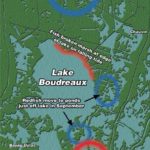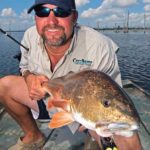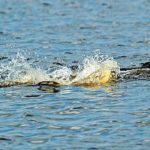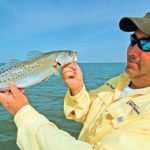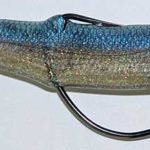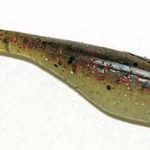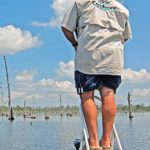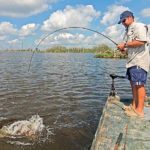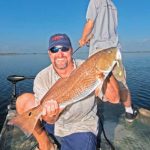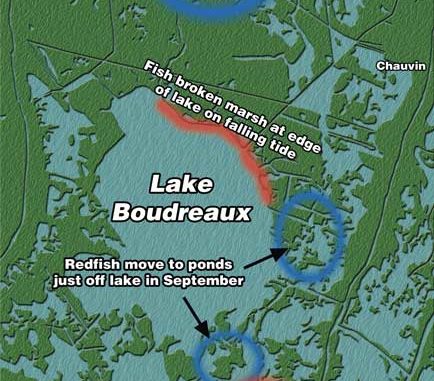
This time of year, massive schools of redfish make the water around Lake Boudreaux turn bronze.
I was thinking to myself how much I have come to HATE getting up at 3:30 to go fishing. Really, who can like that kind of sleep depravation?
Mind you: Every trip is enjoyable, and I treasure every minute on the water. But seriously, would it hurt if I slept until the sun came up?
Those were the thoughts going through my mind this early morning, as the boat in which I rode skimmed toward the shallow pond and I worked to scrub the sleep from the corners of my eyes. The only redeeming part of the morning was that my son Garrett was sitting next to me.
At least he looked ready for some fishing. But, then again, he slept all the way to Houma.
And then adrenaline spiked through my veins, and I was on my feet.
“There they are,” Anthony Kyzar said, pointing to roiling water 100 yards ahead.
While there was bait moving all over the huge pond, Kyzar wasn’t pointing at mullet or minnows. That was clear from the tails sticking out of the water in at least a 50-square-foot stretch of water in the pond just north of Lake Boudreaux.
Kyzar, owner of Cajun Fishing and Hunting Charters, killed the big motor and headed to the front deck. Garrett climbed next to him without a word, antsy to get a lure in the water.
The guide was the first to cast his cocaho, but Garrett wasn’t far behind. As soon as the baits hit the feeding school, both anglers set the hook and began wrestling reds to the boat. They ran around the 18-foot craft, hooting and passing their rods through each other’s arms to keep their lines from tangling.
A few minutes later, the first two reds were kicking in the ice.
And then Kyzar pointed the bow toward a cove along the shoreline.
“They look like sharks,” Garrett said.
The 40-yard-wide divot was chock-a-block full of redfish wallowing around in inches of water. But these weren’t tailing reds: Half of their backs were visible. They wriggled through the inches-deep water churning up mud and splashing about.
Another couple of casts, and Kyzar and Garrett were fighting more reds.
But those were the only bites coming from the school, a fact that didn’t surprise Kyzar at all.
“They love to get in that 6 inches of water, but it’s hard to get them to bite,” he said. “Your strike zone is so small.”
So he ignored most of the schools that were squirming around in a few inches of water.
“You want to get out in that 1½ foot of water, and when they’re schooling in that depth, you can catch a fish every cast,” Kyzar said.
That’s how the morning went, with Kyzar trolling through the pond so redfish could be picked off from roving schools.
And then it was over: About 8 a.m., it seemed the schools vanished.
Kyzar didn’t waste much time making a move. We ran out the far end of the pond, and made passes through adjoining bodies of water. He never even slowed down.
“There’s no grass,” he explained. “You’ve got to find grass. When you do, you find fish.”
Sure enough, these ponds were devoid of vegetation. Kyzar said that’s one of the problems with the shallow ponds surrounding Lake Boudreaux.
“When the water gets too hot, the grass will die back,” he explained. “If you don’t have grass, you won’t find any fish.”
That proved to be true. Not a single redfish spooked as Kyzar ran through these grassless waters.
After fruitlessly moving from pond to pond, the guide ran back to the original large lake to see if the fish had regrouped. There were fish moving again, and we picked up right where we left off.
Kyzar said that’s why he loves fishing the Boudreaux area this time of year: The waters are packed with redfish, and he has lots of options.
In the heat of the summer, he’ll spend most of his time in the main lake.
“When the water gets so hot, the fish move out of these little ponds into the lake and school up again,” he said. “You can catch them just like this.”
September is a real transitional month, however, with reds beginning the month in the lake but moving back into the ponds as the nights cool down.
“In September and October, they start moving back into the ponds, and they are so easy to catch,” Kyzar said.
And because the lake and its surrounding marshes are protected by highways on all sides, there is always pretty water.
“You can pretty much find clean water no matter the conditions,” Kyzar said. “Say you leave out of Cocodrie and the wind is blowing 30 mph. You can salvage a bad day staying on the inside and catching reds around Lake Boudreaux.
“If you find the grass, you can find clean water.”
Because he is so fond of shallow-water fishing, Kyzar prefers an incoming tide.
“The incoming tide pushes the baitfish into the shallow ponds, and the redfish follow,” he said.
But there is a breaking point when the water gets too high.
“You don’t want an inundation of water,” Kyzar said. “If you get a 30-mph southwest wind for two or three days combined with a real high tide, it just scatters the fish.”
He also stays out of the ponds when the tide is ripping.
“I like a normal 1- to 1½-foot tide,” Kyzar said. “If it’s more than that, it muddies up the water.”
However, when the tide turns, anglers can simply move to the edges of the lake and catch redfish when they’re pulling out of the ponds.
“You can fish the broken marsh, working points and clumps of grass with current passing around them,” Kyzar said.
When fishing close to these more-open areas, Kyzar said there are two ways to locate fish.
“Bring a pair of binoculars,” he said. “You can see a big school of fish a long way off.”
He also said it sometimes pays to simply get on plane and run.
“Just ride the shoreline, and if you see fish move, that’s good,” Kyzar said. “Make a mental note of the location, and let it settle down. Then come back, and the fish will still be there.”
Because this is a time when schools are so easy to find, however, Kyzar usually ignores those areas in which he sees only a fish or two.
“With a school of fish compared to a single fish, you have that competition factor,” Kyzar said. “They’re not going to let their buddy get that lure.
“When you find a school of 30 or 40 fish, if you drag a bait through the middle of that school, it’s going to get bitten.”
Capt. Anthony Kyzar can be reached at (985) 857-8552 or (985) 870-5909.
